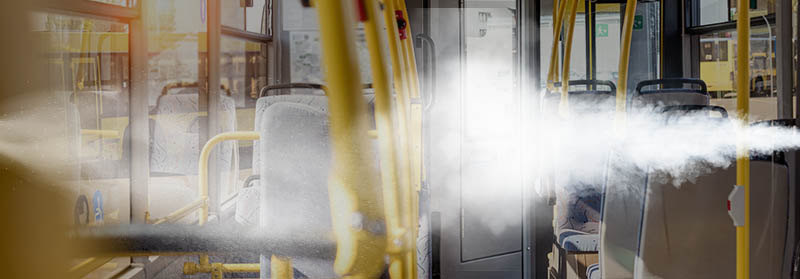
Timely insights on whole room disinfection.
HealthcareApril 24, 2020
It’s All in the Delivery: Unpacking the Benefits of Dry-Fog Delivery Over Electrostatic Sprayer Methods

When it comes to whole room disinfection, selecting the right delivery method is often as critical as selecting the right disinfectant formula—particularly when it comes to high-stakes events like the COVID-19 pandemic. Previously, we’ve discussed the shortcomings of ultraviolet (UV) light for killing pathogens. In this blog, we will explore the limitations of electrostatic sprayers as a delivery method for disinfectants.
Often lauded as less labor intensive and less prone to human error than spray-and-wipe delivery, electrostatic sprayers capitalize on their comparative ease of use and convenience over manual wiping methods to provide value to users. Electrostatic sprayers deliver disinfectants in wet spray format by applying positive electric charges to liquid disinfectants which repel off one another, producing a “beading effect”. These beads of disinfectant cover targeted surfaces, and when spread uniformly, can eliminate pathogens.
While this method does offer several benefits in comparison to spray-and-wipe disinfectants, when considering an electrostatic sprayer versus delivery via dry fog, there are a number of shortcomings. Let’s explore:
1. Labor
High-traffic environments such as public transportation, hospitals, and gyms often require quick treatment and turnaround of large areas of surface with limited staff. These spaces demand delivery methods that are as easy to use as they are effective. In some regards electrostatic sprayers fit the bill; they do not require a team of disinfection personnel to wipe surfaces. And yet, they do require a human operator who must be present throughout the duration of a disinfection cycle to spray disinfectant on all surfaces in a room. If an operator misses a surface, pathogens remain on surfaces believed to be completely disinfected. Beyond the labor requirements associated with delivery, electrostatic sprayers have of maintenance requirements ranging from charging batteries, to diluting disinfectant before spraying, to draining and flushing the device after use. These steps challenge the notion that electrostatic supplication is a ‘low-labor’ solution.
Further still, electrostatic application devices can present a safety risk to operators who may be exposed to the disinfectant chemical on an ongoing basis. Preventing exposure requires that the operator take the precaution of donning personal protective equipment (PPE) prior to every disinfection cycle to protect their health and wellbeing.
The dry-fog delivery difference: In contrast, dry-fog methods do not require an operator to perform delivery of the active ingredients. Instead, the system is simply turned on and operates in a touchless mode until the disinfection cycle is completed. This eliminates the possibility that human error will leave surfaces untreated. Fogging, unlike electrostatic application, reaches all exposed hard surfaces in a room, decreases labor cost, and greatly reduces risk of operator exposure to chemicals. Further still, best-of-breed dry fogging solutions have practically no maintenance requirements beyond refilling the fogger with disinfectant.
2. Time
Oftentimes, the environments that most require disinfection are in continuous use, and therefore have short windows when disinfection can take place. This proves a second shortcoming for electrostatic delivery methods. Surfaces must be sprayed for a set duration in order for the solution to “bead” and effectively kill pathogens—not to mention drying time after the solution is applied. If usage guidelines are not followed and dwell time is cut short, operators risk leaving infectious pathogens behind.
The dry-fog delivery difference: Not only is dry-fog delivery inherently time saving from a labor perspective, it is reliable and repeatable. The fogging cycle permits treatment of multiple spaces with one base fogging machine and multiple nozzle assemblies to treat spaces in rapid sequence.
3. Residue
Electrostatic sprayers require surfaces to be completely wet for disinfection to take place and can leave behind water marks and a wet residue. In environments such as healthcare facilities where sensitive electronic equipment is utilized, this wet delivery can ultimately lead to damage. Beyond residue, electrostatic sprayers have also proven to vary in efficacy across surface types. For example, sprayed disinfectants tend to run off latex surfaces as the uniform “beading” coverage required for disinfection efficacy can’t be created on this material.
The dry-fog delivery difference: A dry fogging system is ‘dry’ by its very nature, meaning that disinfectants are never deployed wet. As part of this dry delivery, they neither leave a residue on surfaces nor damage costly equipment.
The Uniform Coverage Provided by Dry-Fog Delivery
From decreasing labor, to minimizing the risk of human error to protecting operators and equipment, dry-fog delivery presents a myriad of benefits. At Halosil, we enable our customers to tap into the true value of dry-fog delivery through our Halo Disinfection System®. By combining our proprietary HaloMist™ (EPA Reg. No. 84526-6) disinfectant with the HaloFogger®, we provide the uniform disinfection delivery required to effectively disinfect against pathogens.
Ready to leverage dry-fog disinfection in your environment? Contact Halosil today.